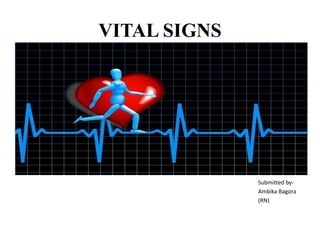
vitalsigns-180617200506 2.pdf
- 1. VITAL SIGNS Submitted by- Ambika Bagora (RN)
- 2. “Temperature, Pulse, Respiration and Blood Pressure are the vital signs, these are also called as cardinal signs.”
- 3. • They reflect the body’s physiological status and provide information about the person with current condition or state of health. • The frequency of vital signs assessment depends upon the person’s condition. The more critical the patient’s condition is, more often these signs are needed to be taken and evaluated
- 4. When to assess vital signs- On the patient admission. During physical examination. Before and after any invasive diagnostic or surgical procedure. Monitoring during recovery. Before and after medications that affect cardiovascular or respiratory functions. In any emergency medical condition.
- 5. Body Temperature Body Temperature is the balance between heat produced and heat lost by the body. *Heat production in the body is called thermogenesis. *Heat loss to the environment is called thermolysis.
- 7. Normal range of body temperature (Adults)- Body region Temperature(oC) Temperature(oF) Oral / Tympanic 37 98.6 Rectal 37.6 99.6 Axillary 36.4 97.6
- 8. FORMULA OF CONVERTING TEMPERATURE UNIT-
- 9. TYPES OF THERMOMETER- A. Glass thermometer- Mercury glass thermometer is used for measuring oral, rectal, and axillary temperature. It takes about 2-8 min for accurate result.
- 10. B. Electronic thermometer- It is used to measure oral, axillary and rectal temperature. It takes about 2 min to 30 seconds for accurate reading.
- 11. C. Disposable thermometer- It is a chemical thermometer. Colour of chemical unit changes to specific temperature. It takes about 60 seconds for accurate reading.
- 12. D. Tympanic Thermometer- It is used to measure ear temperature/ tympanic temperature. It takes about 2-3 seconds for accurate reading.
- 13. FEVER Body temperature above than normal is called as fever or hyperthermia. The person having fever is indicated as febrile. Fevers can be categorised in different ways- a. Low grade fever - above 37.1oC but below 38.2oC . b. High grade fever - above 38.2oC. c. Hyperpyrexia - Higher than 40oC
- 14. d. Intermittent fever- Alternate febrile episodes with periods of normal temperature. e. Remittent fever- Continuous fever but variations throughout a day.
- 15. ORAL METHOD Conscious and alert patients, Cooperative patients. Children below 5 years of age Unconscious patients Oral infections Tachypnoea RECTAL METHOD Unconscious patients Mouth breathers Children Tachypnoeic patients Haemmorrhoids Rectal surgery Rectal fissures Axillary Method Most preferrable method Infants and young children Old age patients Least accurate Time consuming METHODS OF MEASURING BODY TEMPERATURE METHODS INDICATIONS CONTRAINDICATIONS
- 16. PULSE The pulse is an index of the heart’s rate and rhythm. Pulse provides valuable data about person’s cardiovascular status. DEFINITIONS- “The pulse is a wave of blood created by contraction of the left ventricle of the heart.”
- 17. Sites of monitoring pulse- There are 9 sites where pulse can be commonly taken. These are- 1. Temporal- 2. Carotid-
- 20. 7. Popliteal- 8. Posterior tibial-
- 21. 9. Dorsal pedis-
- 23. PULSE RANGE- Normal pulse rate varies depending on age. For a healthy adult the normal resting pulse ranges from 60-100 beats per minute. Tacahycardia- An abnormal rapid heart rate over 100 beats/min. Bradycardia- An abnormal slow heart rate below 60 beats/min. Bounding- Strong full force pulse.
- 24. Thready/ weak- Difficult to palpate, a pulse of diminished strength. Absent- No palpable pulse. Irregular- When interval varies between pulse. Bigeminal pulse- A regular irregular pulse accuring with premature beats. Dicrotic- A split or double pulse beat the second being weaker than first.
- 25. RESPIRATION * Respiration is the process of bringing oxygen to body tissues and removing carbon di oxide from it. The lungs play a major role in this process. * Respiration is the act of breathing which refers to two process- 1. External respiration 2. Internal respiration
- 27. Characteristics of respiration- 1. Respiration rate: It indicates the number of times the person breathes in and out in one minute. 2. Depth: It is estimated by observing the movement of chest during inspiration, which may be deep or shallow. 3. Rhythm: It indicate the equal interval between two respiration.
- 28. Normal respiration- Normal respiration is autonomic, effortless, and regular. The normal adult rate of respiration is generally ranged between 14-20 breaths/minutes. How to take respiratory rate- Place the patient arm in relaxed position across his abdomen and place your hand on the patient’s arm. Now observe complete respiratory cycle (Inspiration + expiration).
- 30. SOME TERMS OF RESPIRATION- Tachypnoea- An increased respiratory rate more than 24 breath/min. Bradypnoea- A decreased respiratory rate less than 10 breath/min. Apnoea- Total cessation of breathing or respiratory rate. Hyperapnoea- Increase in the depth of respiration.
- 31. BLOOD PRESSURE (BP) BLOOD PRESSURE is the force exerted by the blood against the vessels walls (arterial wall) which is measured in millimeter of mercury (mmHg).
- 32. Blood pressure measurements includes systolic and diastolic pressures- Systolic pressure- The maximal pressure exerted on the arteries during contraction of left ventricles of heart. Diastolic pressure- The amount of pressure exerted on the arterial wall with the ventricles at rest.
- 33. Methods of measuring blood pressure (BP)- 1. Direct method- An oscilloscope is used for this method. This is a continuous method which measures mean pressures. A needle or catheter is inserted into the brachial, radial or femoral artery and oscilloscope displays arterial pressure in wave form.
- 34. Indirect method- Taking blood pressure by using sphygnomanometer. Following types of measuring device is available- 1. Mercury manometer 2. Aneroid manometer 3. Electronic BP device
- 35. Normal blood pressure in an adult varies between 100 to 140 mm of Hg systolic and 60 to 90 mm of Hg diastolic but BP may vary widely depending on individuals other factors.
- 36. Creativity is a habit, and the best creativity is the result of good work habits.